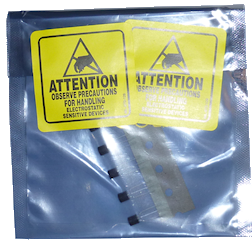67. Static Electricity Precautions
Some electronic parts are hyper-sensitive to static electricity. You
can damage them just by touching them, if your body is charged up with
static. This is especially likely in dry climates - if you live
somewhere dry, you know how often you get zapped touching metal
fixtures. And even if you don't notice blue sparks flying around, you
can still have enough static charge on your body to damage IC chips
and other especially sensitive devices.
There are some simple precautions you should take to avoid this danger
when building circuit boards.
Which parts are sensitive?
An easy way to tell that a particular part is static-sensitive is to
look at its packaging. If it comes in one of those silvered mylar
bags, it's probably sensitive to static.

The parts that are typically most sensitive to static are:
- IC chips
- Transistors
- MOSFETs
- Diodes
- LEDs
- Circuit boards with any of the above
Precautions
First, leave parts in their silvery bags until they're needed, and
keep the bags closed. The bags provide good protection, so it's best
to keep the parts there when you're not actively working with them.
When it comes time to install parts on a board, you obviously have to
take them out of the bags. The basic rule for handling
static-sensitive devices is to ground yourself early and
often.
The term "grounding" is pretty literal. We're not talking about some
kind of meditation exercise. We're talking about literally connecting
yourself electrically to the soil around your house, to dump any
excess static charge on your body into the ground. The Earth is
basically an infinite reservoir of neutral charge, so excess charge
naturally flows into the ground if given a path.
In practical terms, the thing to look for is an appliance with an
unpainted metal case and a three-prong plug. Metal appliance cases
are almost invariably wired to the third prong in the AC plug, which
in turn connects in your house wiring to a big stake somewhere under
the foundation that's driven into the dirt. As long as an appliance
is plugged into a three-prong outlet, its metal case should be
grounded.
A PC tower case is a pretty reliable example of this. The metal back
plate (assuming it's unpainted) is a great grounding surface.
You don't have to keep one hand on a grounded surface the whole time
you're working, although that would certainly be the ideal. A
momentary touch is enough to discharge any static you've accumulated.
Repeating this every few minutes while you're working will prevent new
charge from building up.
Some rules of thumb:
- Ground yourself before taking a part out of its anti-static bag
- Ground yourself again any time you get up and walk around
- Ground yourself again every few minutes in any case
- Avoid wearing static-prone clothes like wool sweaters while working
- Work in an uncarpeted area
Grounding straps
You can buy a grounding wrist strap that keeps you continuously
connected to ground while working - the equivalent of keeping one hand
on a metal surface the whole time, but way more practical. A ground
strap consists of a conductive bracelet that you wear around your
wrist, and a wire that connects the strap to something grounded. Most
types have an alligator clip at the other end of the cord that you're
meant to attach to a grounded metal surface, so they assume that you
have a grounded appliance or metal surface near your work area. You
can also find grounding straps that plug into a three-prong outlet
directly.
If you live in a dry climate, or you do a lot of electronics work, you
might consider one of these. It's probably a bit more trouble than
it's worth if you're only doing occasional hobbyist work. Maybe I've
just been lucky, but in my experience, it's adequate to use the "touch
a metal surface" technique as long as you're diligent about it.